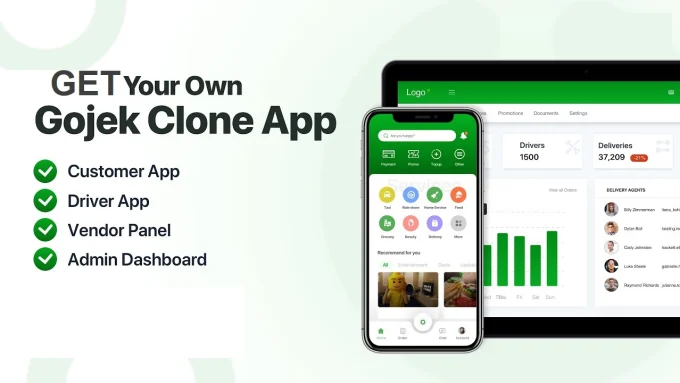How to Build a Super Multi-Delivery App like Gojek
Introduction
In today’s fast-paced world, on-demand services have become increasingly popular. People want quick and convenient access to food delivery, ride-hailing, grocery shopping, and more. Apps like Gojek have revolutionized how we avail ourselves of these services by offering a single platform for multiple delivery services. This article will guide you on building a super multi-delivery app like Gojek, discussing the key features, development process, and benefits.
Understanding the Concept of a Multi-Delivery App
A multi-delivery app, also known as a Gojek Clone App, is a comprehensive platform that integrates various delivery services into a single application. It allows users to access multiple on-demand services such as food delivery, ride-hailing, package delivery, grocery shopping, and more from one app. The Gojek Clone App is designed to simplify the user experience and provide convenience by offering a centralized platform for all their delivery needs. Users can enjoy the benefits of accessing a wide range of services through a single app, making it a one-stop solution for their daily requirements.
Key Features of a Multi-Delivery App
To build a successful multi-delivery app like Gojek, it’s important to incorporate the following key features:
User Registration and Profiles
Allow users to create accounts, sign in, and manage their profiles. Users should be able to save their personal information, payment methods, and delivery addresses for quick and seamless transactions.
Service Provider Registration
Enable service providers to register on the platform, submit their credentials, and complete the verification process. Implement a robust onboarding system to ensure quality service providers join your platform.
Service Selection
Provide users with various services, such as food delivery, ride-hailing, courier services, house cleaning, and more. Categorize services effectively to enhance user experience and enable easy navigation.
Real-Time Tracking
Integrate GPS and mapping functionalities to allow users to track their orders and service providers in real time. This feature enhances transparency and builds trust among users.
Secure Payment Gateway
Incorporate a secure and reliable payment gateway to facilitate seamless transactions. Users should be able to pay for services directly through the app using various payment methods, including credit/debit cards, digital wallets, and online banking.
Ratings and Reviews
Implement a rating and review system to gather user feedback about service providers. This helps maintain service quality and allows users to make informed decisions.
Notifications and Alerts
Send timely notifications and alerts to users regarding order status, promotions, discounts, and important updates. This feature keeps users engaged and informed about the services they avail.
Customer Support
Provide a dedicated customer support system to promptly address user queries, complaints, and issues. Offer multiple communication channels, including chat support, email, and phone calls.
Planning and Designing Your Multi-Delivery App
Before starting the development process, planning and designing your multi-delivery app effectively is crucial. Consider the following steps:
Market Research
Conduct thorough market research to understand your target audience, their preferences, and the competition. Identify the gaps in existing multi-delivery apps and explore unique features to differentiate your app.
User Flow and Wireframing
Create a user flow diagram to define the navigation and interactions within your app. Develop wireframes to visualize the app’s layout and structure. This helps in optimizing the user experience and identifying potential design improvements.
Prototyping and Testing
Build interactive prototypes of your app to simulate the user experience. Test the prototype with potential users to gather feedback and make necessary refinements before proceeding to the development stage.
Developing the App
Once you have a solid plan and design, it’s time to start the development process. Follow these steps:
Backend Development
Set up a robust backend infrastructure to handle user registrations, service provider management, service selection, payment processing, and other core functionalities. Choose a scalable technology stack to accommodate future growth.
Frontend Development
Develop an intuitive and user-friendly frontend interface for your app. Ensure the design is responsive and optimized for various devices, including smartphones and tablets.
API Integration
Integrate APIs of third-party services like map navigation, payment gateways, and SMS gateways to enhance the app’s functionality. Collaborate with service providers to establish seamless communication channels.
Testing and Quality Assurance
Conduct rigorous testing to identify and fix bugs, errors, and performance issues. Perform comprehensive quality assurance to ensure a smooth user experience and overall app stability.
Launching and Marketing Your App
After successful development, launching and promoting your multi-delivery app is time. Follow these steps to make a splash in the market:
App Store Optimization (ASO)
Optimize your app store listing with relevant keywords, attractive descriptions, and high-quality app screenshots. This will increase your app’s visibility and organic downloads.
Social Media Marketing
Create social media accounts for your app and utilize platforms like Facebook, Instagram, Twitter, and LinkedIn to build an online presence. Engage with your target audience, share informative content, and run targeted ad campaigns.
Influencer Collaborations
Partner with relevant influencers and bloggers in the on-demand service industry. Collaborative content creation and endorsements can generate buzz and attract potential users.
Referral Programs and Loyalty Rewards
Implement referral programs to encourage existing users to invite their friends and family. Offer loyalty rewards and discounts to retain users and foster brand loyalty.
Scaling and Improving Your App
To ensure the long-term success of your multi-delivery app, focus on continuous improvement and scalability:
User Feedback and Iterations
Gather feedback from users and analyze their suggestions for enhancements. Regularly update your app to introduce new features, improve performance, and address user concerns.
Expansion and Localization
Consider expanding your app’s services to different geographical regions. Localize your app by translating it into multiple languages and adapting it to regional preferences.
Strategic Partnerships
Explore strategic partnerships with local businesses, service providers, and delivery networks. Collaborations can help expand your app’s reach and offer new services to users.
Conclusion
Building a super multi-delivery app like Gojek requires careful planning, effective design, and robust development. You can create an app that revolutionizes on-demand services by incorporating key features, providing a seamless user experience, and focusing on marketing strategies. Remember to continuously evolve your app based on user feedback and market trends to stay ahead of the competition.




